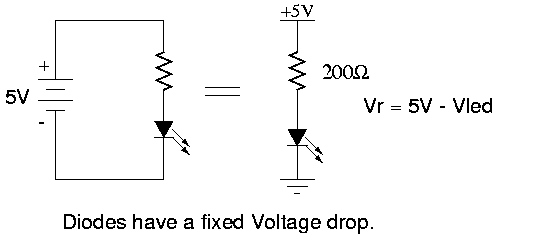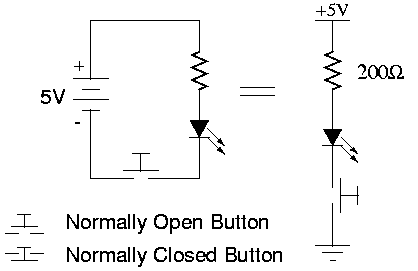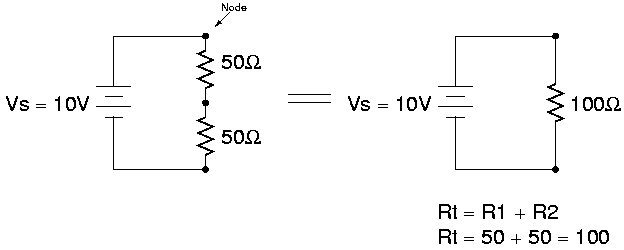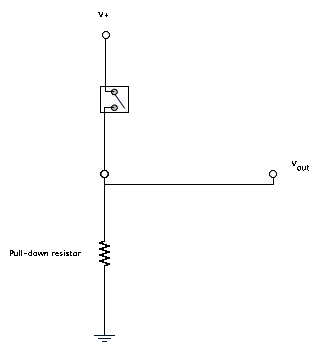Introduction to Electronics (condensed)
Electrical Circuit
An interconnection of electrical elements that contains a closed loop is an electrical circuit. The closed loop allows electrons to flow through the electrical elements. We now explain how to analyze simple electrical circuits in terms of voltage, current, and resistance.
Current, Voltage, Resistance
Current describes the quantity of electrons passing through a point in a circuit at a given instant in time. Current is measured in Amperes (Amps, A).
Voltage describes the potential difference in electrical charge between two points in an electrical circuit. Voltage (also known as electric potential) is measured in Volts (V).
Resistance (a special case of Impedance) describes the capacity of a circuit element to resist or impede the flow of electrons in the circuit. Resistance in measured in Ohms.
A common analogy may be used to relate these three quantities to water flow in pipes in place of electrons in wires. Imagine you have two water tanks connected from the bottoms by a pipe (such as the drain of a double sink). If one tank is full of water and the other one nearly empty we know intuitively that the water in the full tank will flow through the pipe into the nearly empty tank.
Current I0 is analogous to the quantity of water flowing through a pipe at a given moment in time.
Ohm's Law
V = IR Ohm's Law states that Voltage = Current x Resistance or V = IR. The equation can be rearranged to find any one of the three quantities given the other two.
Consider the following circuit:
The voltage in the circuit is given (10V from the battery) and the resistance is also given as the 100 ohm resistor is the only resistive element in the circuit. So we can compute the current in the circuit as: I = V/R = 10V / 100 Ohms = 0.1 Amps or 100 milli-Amps.
Button LED Example
The following circuit diagram shows the most basic LED (Light Emitting Diode) circuit:
For a red LED, Vled is often about 1.7V. Diodes are from the family of semiconductors. Unlike a resistors, diodes always have a fixed voltage drop in a circuit. A diode passes current in only one direction, a very useful property for protecting circuits from incorrect current flow. The arrow in the diode symbol points in the direction that current flows, so normally you would place a diode in your circuit with the arrow pointing to a ground. Kirchoff's Current Law implies that the current flowing throught the resistor is the same as the current flowing through the LED. Therefore, once we know the current passing through the resistor in this circuit, we also know the current passing through the LED. The brightness of an LED is proportional to the amount of current passing through it. How would you make the LED shine brighter? less brightly?
Now consider the following circuit which adds a button:
The button simply interrupts or re-connects the flow of current through the circuit lighting or extinguishing the LED in the process.
Series Circuits
Consider this slightly more complicated circuit:
When two resistors are connected in series, their combined resistance is equivalent to the sum of their individual resistances.
We can use Ohm's law to calculate the voltage drop around each of the individual resistors after calculating the voltage drop accross the total resistance.
We can further rationalize the series circuit by going back to our analogy:
Parallel Circuits
When two resistors are placed in parallel in a circuit, their combined resistance is equal to the product of the individual resistances divided by their sum. (Smaller total voltage for parallel in contrast to larger for series).
One again we use ohm's law to calculate the voltage across the resistors (same for both) and the current through each resistor.
Here we use the water analogy again:
Voltage Divider
Pull-up and Pull-down resistors
Often we would like to set a "default voltage" for a circuit. This is done using pull-up and pull down resistors.
Here is an example of a pull-down resistor in a circuit. When the switch is closed, Vout=Vin, but if the switch is open, Vout=Ground.
Here is an example of a pull-up resistor in a circuit. When the switch is not on any lead, Vout is high.
In general, the R values for pull-up and pull-down resistors should be very large, much larger than those in the rest of the circuit, so that the effect of the pull-up or pull-down resistor on the Vout voltage is small if there is any else "down the line" of the circuit.












